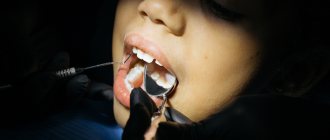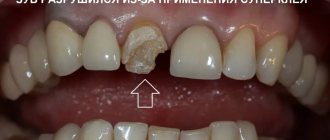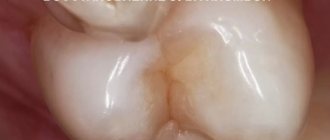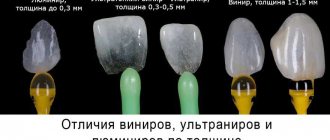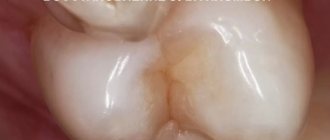Hidden caries (both under a filling and on a “healthy” tooth)
As a rule, such caries develops asymptomatically, for more than one month or even a year, it does not manifest itself in any way, but destroys the tooth tissue from the inside. And at some inopportune moment, a part of the tooth, thinned by caries, breaks off.
What to do?
Treat the tooth at the dentist: remove all tissues affected by caries and restore the tooth (with a filling, ceramic inlay or crown, depending on the degree of its destruction). And be sure to check all other teeth for hidden caries!
How to avoid?
See your dentist for preventive examinations more often in order to promptly detect hidden caries at an early stage, when treatment is easier, faster and cheaper.
Signs of a fracture
It is almost impossible not to notice that the crown is cracked. After all, at the moment of its damage, severe pain appears. The unit soon ceases to be sensitive, as its layers are deprived of adequate nutrition.
To see the location of the defect, you need to carefully examine your smile in the mirror. A crack will be noticeable on the surface, running along or across. It also happens that a large fragment breaks off immediately. Then a sharp break line is formed, which injures the mucous membranes of the inner surface of the lips and cheeks, and the tongue.
Incorrectly restored tooth
- Poor performance of the filling , violation of technology and methodology during restoration (we will not dwell on this).
- The type of restoration is inadequately selected, in a word, “too big a filling” (i.e. they put a filling in cases where it can no longer be placed, but there are all the indications for “more serious” ceramic restorations (inlays, crowns).
I would like to dwell on the second reason in more detail.
Competent dentists know that there is an index of tooth surface destruction (DSI), which must be taken into account before restoring teeth in order to do it correctly. For you, dear patient, I will describe it in a simplified way. If the tooth is not severely damaged (conditionally up to 40% of the surface), a filling is an excellent way to restore it. Destruction of 40 to 70% of the surface requires the manufacture of a ceramic inlay or strengthening of the tooth with various pin structures.
If there is a significant degree of destruction of the tooth surface (more than 70%), the tooth should be correctly restored with a crown. In a word, the type of tooth restoration depends on the degree of destruction.
What's wrong with a filling?
Each recovery method has its own indications. So, a filling is necessary and can be placed in cases of small and medium degrees of tooth decay. If the decay is significant, a large filling can split the tooth in half.
Let's find out why!
Any material (even metal) expands when heated (remember the temperature of the tea you drink!). Temperature changes are a fairly common occurrence that our teeth encounter (from hot tea to ice cream). The coefficient of thermal expansion of filling materials is still higher than that of tooth tissue. That is, when hot food is consumed, the filling expands more than the tooth tissue that surrounds it. The larger the volume of the filling, the greater the expansion (this is why a large volume of the filling is so undesirable).
Of course, this expansion is minimal, not noticeable to any eye and not perceptible. However, add to it a chewing load (which far exceeds temperature deformations), a large filling, thinned tooth tissue, and the likelihood of chipping increases many times over.
Unlike filling materials, ceramics (from which crowns and inlays are made) have a closer coefficient of thermal expansion to the tooth tissues, and therefore do not contribute to its chipping. In addition, it is stronger. That is why it is correct to restore severely damaged teeth not with fillings, but with ceramic restorations. There are other physical phenomena that affect the change in the size of the filling and, as a result, the splitting of the tooth.
All of the above, of course, is true only with an adequately completed restoration (even fillings, even crowns). An inaccurate hand of a master can lead to chipping even with ceramic restorations, and on the contrary, a skillful hand can place a large filling so that it will last a long time. However, there is a limit to everything and it is better not to go beyond the indications for restorations if you want to get guaranteed and reliable work.
Conclusion : you should not expand the indications for conventional fillings too much; they are not capable of qualitatively restoring a badly damaged tooth. But in case of minor tooth decay, fillings have proven themselves to be excellent!
Let me give you a photographic example.
The patient complained that it was painful for her to bite on one of her teeth, that something “crunched” in it.
Upon examination, we determined: tooth 4 on the upper jaw: it has a medium-sized filling (at first glance). And a movable, broken tooth wall, which is held together only by the gums. This wall is no longer attached to the tooth.
The broken fragment of the tooth is mobile, easily moved to the side, but has not yet been removed.
View of the tooth after removing the broken wall: the cheek wall was chipped under the gum. A large filling and a thin remaining tooth wall on the palatal side are visible. Some doctors may try to restore such a tooth using a crown (with preliminary extension); some doctors will offer a perhaps more predictable option: removal and subsequent implantation.
Why are teeth restored incorrectly?
It’s absurd, but often the dentist follows the patient’s lead. The patient, not fully understanding all the subtleties and features of the distribution of the load when chewing, refuses the inlay or crown and asks the doctor to “put a filling”, they say, I’ll work with it a little more, and only then the crown! As a result, at the most inopportune moment, a “piece” of the tooth breaks off. As a result, such “pity” of the doctor for the patient turns out to be a bigger problem for the patient than timely adequate tooth restoration.
By clicking on the “Make an appointment” button, I consent to the processing of my personal data.
I have read and agree with the conditions for processing personal data set out on the website ds-chocolate.ru.
Consent to the processing of personal data
How to properly restore teeth?
When treating a tooth, the doctor must remove all carious tissues, old fillings, movable walls, if any, completely clean the tooth and only then assess the degree of destruction (which walls and cusps have survived, whether they are able to bear the load, how the load on this tooth will be distributed during different methods of restoration, whether chips of any wall are possible, whether its restoration will lead to a split of the root, etc.). After such an assessment, it is determined how to properly restore the tooth: is it possible to put a filling, or does it need to be “strengthened with a pin,” or would it be more correct to use a ceramic inlay or a crown.
Conclusion: a properly selected restoration will preserve the tooth for many years, protect it from further destruction, and the patient from having to redo the work in a few years.
How to avoid a fracture
Preventive measures seem very simple, but many people ignore them. And absolutely in vain, since their effectiveness has been confirmed by dentists.
To reduce the risk of damage to the root unit, you must:
- Visit your dentist once a year. The doctor will check for diseases. If any pathologies are detected, they will be treated. At the same time, he will carry out professional oral hygiene. Thanks to it, soft plaque and hard stone will be removed, the condition of the gums will improve, and the enamel will begin to better absorb nutrients.
- Close carious cavities in a timely manner. Caries is a gateway for the penetration of pathogenic organisms into the deep structures of the tooth. It leads to the fact that the corinca part becomes completely weak and splits.
- Eat a balanced diet. Your daily diet should include fresh vegetables and fruits. They are natural “trainers” for the jaws and provide the body with minerals and vitamins.
- Pay special attention to hygiene measures. It is important to use a high-quality fluoride-containing toothpaste when cleaning. The brush should not be too hard.
- Limit the amount of sweets. They harm not only your teeth, but your overall health.
Anyone can experience a crown or root fracture. This is a state that cannot be delayed. Do your best to never run into him. If the unit does break, go to the doctor immediately. Do not self-medicate under any circumstances.
Injury
Single or chronic - the third reason for possible tooth chips
A single injury occurs when there is a blow, an accident, or accidentally biting on a hard object while chewing.
There are three types of chronic injury
- Due to malocclusion (when the teeth do not close correctly, some teeth may receive excessive load, close in the wrong areas, at the wrong angle, or with an opponent that is not their power). For example, a powerful fang of the lower jaw can be positioned in such a way that when closed, it will severely injure the incisor on the upper jaw, which is much inferior to it in size and power. As a result of such long-term closure, the incisor can get into big problems, and the patient will face the need for treatment or removal.
- Due to the absence of other teeth (when a number of teeth are missing, their work is performed by the remaining ones; excessive load may one day result in a fracture of the tooth, a break in its wall, or a split in the root).
- Due to bruxism (“idle” teeth grinding) or other parafunctional manifestations.
How to avoid?
- Be sure to restore missing teeth (there are a lot of ways today, there are even temporary prosthetics if for some reason you need to postpone dental treatment).
- Consult an orthodontist, orthopedist or periodontist about bite problems and undergo orthodontic treatment if indicated.
- Get advice from an orthopedist/gnathologist and psychotherapist about the possible causes of bruxism and take possible measures that the doctor recommends.
When you have to remove a broken tooth along with the root
Tearing out a broken unit is the most undesirable scenario for any patient, because artificial units, no matter how high-quality and beautiful they are, are still inferior to natural ones. Unfortunately, it is not always possible to save a damaged tooth. Removal is indicated when:
- root damage;
- putrefactive processes in the deep tissues of the gums and jawbone;
- root fracture.
Since the crown is broken, it is impossible to remove debris from the gums using the classical method. The doctor administers anesthesia. Then he cuts through the gum and gets access to the roots. Removes them one by one.
When the wound heals, discusses with the patient how to close the dental defect. In some cases, a decision is made to perform simultaneous implantation with immediate loading. Then, immediately after the operation, the patient goes home with a pin and a temporary crown implanted into the jawbone. The latter will soon be replaced with a permanent one.
What to do if your tooth chipped?
See a dentist.
The doctor will remove the broken wall, take x-rays of the tooth, and evaluate its safety. If the tooth is not broken much, the root is not damaged or almost not damaged, then it can be restored. Then the tooth is prepared (if necessary, dental canals are treated, caries and old filling materials are cleaned), how badly it is damaged is assessed and the best way to restore it is selected (filling, inlay or crown). If the tooth cannot be saved, it is removed and replaced with an implant or other available method.
Diagnosis and treatment
Only a dentist can determine the exact cause of blackening of the tooth root. To identify the provoking factor, doctors use different diagnostic methods:
- inspection,
- dental radiography,
- electroodontometry.
The treatment regimen is drawn up individually for each patient, taking into account the clinical picture. If you have tartar, professional teeth cleaning is recommended. If the darkening of the enamel is caused by caries, it is necessary to clean the carious cavity and install a filling.
Causes of blood taste in mouth
Sometimes, in addition to the unpleasant smell, the patient is also bothered by the taste of blood in the mouth. Possible reasons for such sensations:
- Gingivitis develops, inflammation of the gums around the crown. The mucous membrane can become inflamed for various reasons. For example, the prosthesis fits tightly to the soft tissues, constantly rubbing them.
- The crown scratches and injures the adjacent gum. Blood is released, infection enters the wound, the mucous membrane becomes inflamed and bleeds. This only happens if the crown is not fixed correctly or if its dimensions are violated. Needs a complete refurbishment.
- Bleeding can cause unsatisfactory treatment of the tooth before placing a prosthesis. Poor filling of canals or incomplete removal of the pulp invariably causes inflammation and accumulation of purulent masses. Tissues are destroyed with the release of blood.
The appearance of blood discharge in the oral cavity should not be ignored. Pathogens easily penetrate an open wound, causing great damage to human health.
